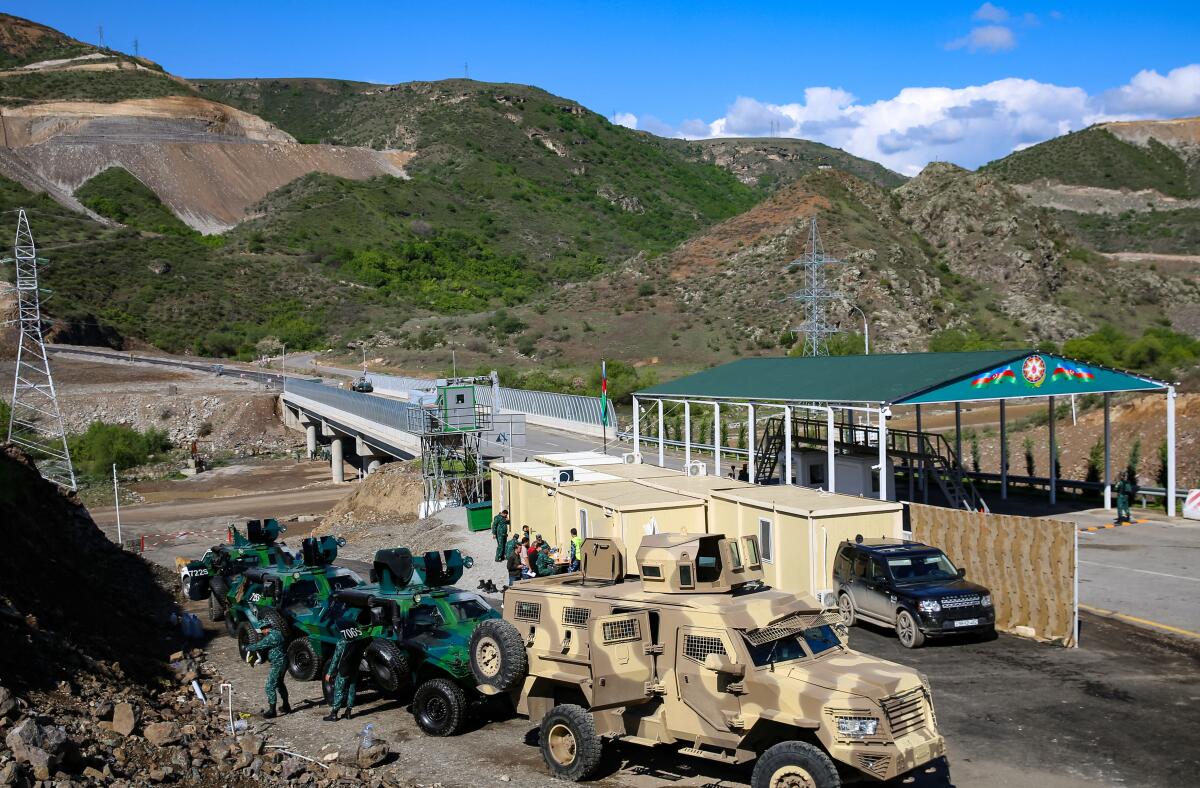U.S. tries to stop war between Armenia, Azerbaijan in an already volatile region

- Share via
WASHINGTON — The Biden administration hosted risky peace talks this week between bitter South Caucasus rivals Armenia and Azerbaijan, hoping to avert a second major war in the region but failing to bridge stubborn differences between the two sides.
The talks — the first to bring together the foreign ministers of the two countries in a room for multiple days — started Sunday night and wrapped up Thursday.
U.S. Secretary of State Antony J. Blinken, signaling the conclusion of the meetings, was unable to announce any decisions.
“The two sides have discussed some very tough issues over the last few days and they’ve made tangible progress on a durable peace agreement,” Blinken said. “I hope that they see — and I believe that they do, as I do — that there is an agreement within sight, within reach.”
Blinken said he expected more talks would take place, but did not offer a detailed schedule.
“The last mile of any marathon is always the hardest; we know that,” Blinken said as he thanked his Armenian and Azerbaijani counterparts for their efforts. “But the United States is here to continue to help both of our friends cross the finish line. And as I say, I think we’re very much within reach of that.”
Reports from the Azerbaijani capital, Baku, indicated progress toward “mutual understandings” that could form part of an eventual peace accord, but with significant differences remaining.
Throughout the week, U.S. officials had refused to give updates on the talks while also voicing optimism about a possible breakthrough.
“We remain committed to promoting a peaceful future for the South Caucasus region,” State Department spokesman Vedant Patel said on Wednesday. “We believe that peace between these two countries is possible. We believe that there is not a military solution to this.”
But military actions have overshadowed diplomatic gestures in recent months. The two former Soviet republics have had territorial disputes for years. Fighting in 2020 killed nearly 7,000 soldiers, and deadly skirmishes broke out again last month.
The crux of the dispute is a breakaway enclave of territory within Azerbaijan that is populated by ethnic Armenians and controlled by pro-Armenian separatists. The contested region is known to Azerbaijan as Nagorno-Karabakh, and to Armenians as Artsakh, a mountainous area slightly larger than Rhode Island.
Russia, the European Union, Turkey and even Iran have had their fingers in the Armenia-Azerbaijan conflict at one time or another. The United States stepped into the fray late last year when Blinken, on the margins of the United Nations General Assembly meeting in New York, pulled together his counterparts, Ararat Mirzoyan of Armenia and Azerbaijan’s Jeyhun Bayramov, for an initial contact.
Blinken was overseeing this week’s talks with Mirzoyan and Bayramov, who have consistently appeared somber in photographs released from the meeting site just outside Washington.
Ahead of the meetings, Blinken spoke with the top leaders of both countries, urging diplomacy but also scolding Azerbaijan for blocking access to Nagorno-Karabakh by setting up a checkpoint along the Lachin Corridor, the lone land route between Armenia and the disputed enclave.
Armenia claims the restricted access has denied the population food, medicine and other humanitarian necessities.
“We have not parsed our words about the need for the free flow of traffic and people and commerce through the Lachin Corridor,” Patel said. “That continues to be the case.”
The U.S. is often seen as favoring Armenia, primarily because of support in Congress for large Armenian American constituencies in Southern California and elsewhere.
But some U.S.-based pro-Armenia activists criticize the Biden administration for continued military aid to Azerbaijan and what they consider to be insufficient humanitarian aid for the Nagorno-Karabakh region.
“For our government to truly act as an honest broker, they must stop military aid to the aggressor,” said Aram Hamparian, executive director of the Armenian National Committee of America. He was not optimistic about the outcome of this week’s meetings.
The Azerbaijani Embassy in Washington did not return calls seeking comment.
Alliances in the conflict have shifted over the years. Initially, Russia backed majority-Christian Armenia over majority-Muslim Azerbaijan, which had the support of Turkey.
But Russia is now bogged down in its disastrous war on Ukraine and less able to supply Armenia with weapons and other material support, analysts say. Armenia incurred heavy losses in the fighting in 2020 and was forced to cede some territory to Azerbaijan under the terms of a Russia-brokered cease-fire agreement.
A report by the U.S. Office of the Director of National Intelligence late last year predicted Azerbaijan would be the “country most likely to renew large-scale conflict” in an effort to “consolidate and expand the gains” from 2020.
“Armenia is less likely to initiate fighting because of the deteriorated state of its military in the aftermath of the 2020 conflict,” the report says. “The Armenian Armed Forces suffered heavy equipment and personnel losses during the conflict in 2020 and have been unable to reconstitute because of funding and procurement issues.”
That may make Armenia more willing to compromise, analysts say, despite what some perceive as having the U.S. in its corner.
More to Read
Get the L.A. Times Politics newsletter
Deeply reported insights into legislation, politics and policy from Sacramento, Washington and beyond. In your inbox twice per week.
You may occasionally receive promotional content from the Los Angeles Times.











